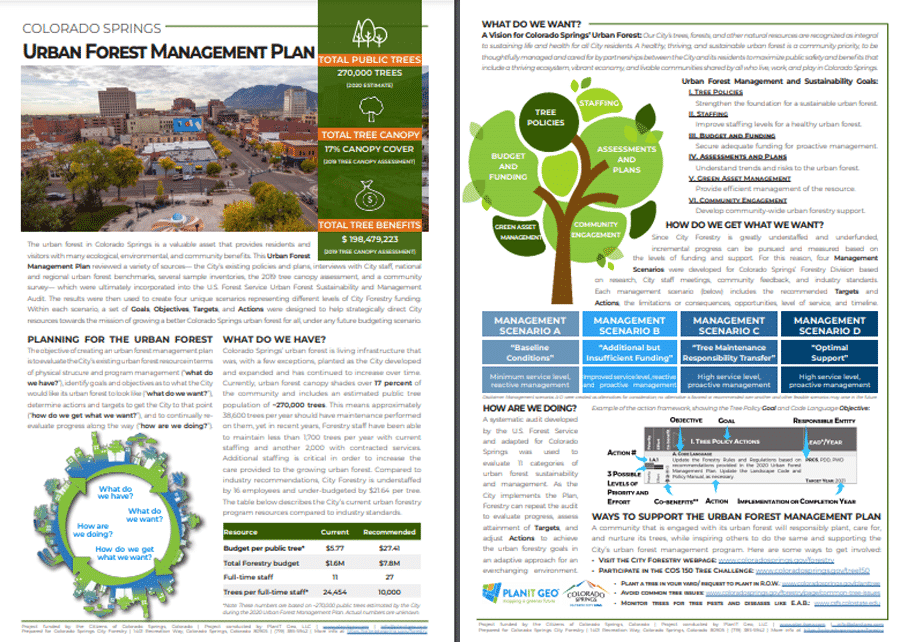Urban Forest Management Plan: Project Summary
Colorado Springs, ColoradoThe urban forest in Colorado Springs is a valuable asset that provides residents and visitors with many ecological, environmental, and community benefits. This Urban Forest Management Plan reviewed a variety of sources— the City’s existing policies and plans, interviews with City staff, national and regional urban forest benchmarks, several sample inventories, the 2019 tree canopy assessment, and a community survey— which were ultimately incorporated into the U.S. Forest Service Urban Forest Sustainability and Management Audit. The results were then used to create four unique scenarios representing different levels of City Forestry funding. Within each scenario, a set of Goals, Objectives, Targets, and Actions were designed to help strategically direct City resources towards the mission of growing a better Colorado Springs urban forest for all, under any future budgeting scenario.
Planning For The Urban Forest
The objective of creating an urban forest management plan is to evaluate the City’s existing urban forest resource in terms of physical strucure and program management (“what do we have?”), identify goals and objectives as to what the City would like its urban forest to look like (“what do we want?”), determine actions and targets to get the City to that point (“how do we get what we want?”), and to continually reevaluate progress along the way (“how are we doing?”).
What do We Have?
Colorado Springs’ urban forest is living infrastructure that was, with a few exceptions, planted as the City developed and expanded and has continued to increase over time. Currently, urban forest canopy shades over 17 percent of the community and includes an estimated public tree population of ~270,000 trees. This means approximately 38,600 trees per year should have maintenance performed on them, yet in recent years, Forestry staff have been able to maintain less than 1,700 trees per year with current staffing and another 2,000 with contracted services. Additional staffing is critical in order to increase the care provided to the growing urban forest. Compared to industry recommendations, City Forestry is understaffed by 16 employees and under-budgeted by $21.64 per tree.
Key Insights
Total Public Trees
Total Tree Canopy Cover
Total Tree Benefits
What Do We Want?
A Vision for Colorado Springs’ Urban Forest: Our City’s trees, forests, and other natural resources are recognized as integral to sustaining life and health for all City residents. A healthy, thriving, and sustainable urban forest is a community priority, to be thoughtfully managed and cared for by partnerships between the City and its residents to maximize public safety and benefits that include a thriving ecosystem, vibrant economy, and livable communities shared by all who live, work, and play in Colorado Springs

How Do We Get It?
Since City Forestry is greatly understaffed and underfunded, incremental progress can be pursued and measured based on the levels of funding and support. For this reason, four Management Scenarios were developed for Colorado Springs’ Forestry Division based on research, City staff meetings, community feedback, and industry standards. Each management scenario (below) includes the recommended Targets and Actions, the limitations or consequences, opportunities, level of service, and timeline.
